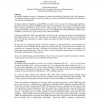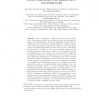140 search results - page 14 / 28 » Mesh Reduction with Error Control |
DAC
2007
ACM
14 years 10 days ago
2007
ACM
RLC circuits have been shown to be better formulated as second-order systems instead of first-order systems. The corresponding model order reduction techniques for secondorder sys...
SIAMSC
2011
13 years 3 months ago
2011
Abstract. In this paper, we propose new adaptive local refinement (ALR) strategies for firstorder system least-squares (FOSLS) finite element in conjunction with algebraic multi...
CSDA
2008
13 years 8 months ago
2008
In multiple hypotheses testing, it is important to control the probability of rejecting "true" null hypotheses. A standard procedure has been to control the family-wise ...
CGI
2006
IEEE
14 years 2 months ago
2006
IEEE
Abstract. A new adaptive tessellation method for general CatmullClark subdivision surfaces is presented. Development of the new method is based on the observation that optimum adap...
EUROCRYPT
2007
Springer
14 years 2 months ago
2007
Springer
Abstract. Secure computation consists of protocols for secure arithmetic: secret values are added and multiplied securely by networked processors. The striking feature of secure co...


